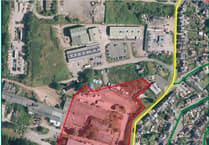October's early ground frost hastened the autumn colours around the Forest. Bracken is very frost tender, surprisingly so for a plant that dominates many upland areas, and in sheltered places it has already assumed the orange hue that will add colour to Forest scenes through-out the winter.
Our native oaks are always slow to lose their summer green but in places small numbers of North American oaks have been planted and these in contrast have spectacular colours in the autumn. They can usually be identified by their more spiky leaves. Just south of Cannop crossroads a few have been planted opposite where the old wood distillation plant used to be and they stand out now, their leaves burning a fiery scarlet.
Another 'foreigner' that is looking resplendent is the mandarin duck. Most wildfowl look very scruffy during their summer moult and the drakes lose all their bright plumage. Now the moult is finished they look bright and sharp and the mandarins are no exception.
The males with their red beaks, their plumed heads, chestnut ruff and triangular orange sails on their backs could not look more exotic. Over the last ten years they have made themselves at home on Forest ponds and can be seen now at Soudley, Mallard's Pike, Cannop Ponds and other sites, mainly in the central part of the Forest.
Mandarins look exotic and they are exotic.
Their natural breeding range is in south-east Asia where they can be found in China, Japan and Korea. In that area numbers have been thought to be declining.
In Britain they have escaped from wildfowl collections and established themselves in the wild through much of southern England. Where the habitat suits them they breed readily. As they like areas of open water surrounded by woodland with old trees, the Forest must be something of a mandarin paradise.
Woodland supplies mandarins with both food and nesting sites. Most of our native ducks nest on the ground but a few such as the goosander, a winter visitor to the Forest, and the goldeneye nest in hollow trees.
This is where mandarins nest and in the spring they can often be seen perched 20-30 feet up among the branches of the old oaks. When mandarins first arrived the sight of ducks perched high in the oaks surprised many visiting birdwatchers. In autumn and winter the woodlands provide food for mandarins who eat seeds such as acorns and beech nuts, often going into the woodlands to feed during the hours of darkness.
At this time of year they gather together to go through their courtship routines and large groups may be seen. Their liking for woodland means they are quite at home perching in the branches of trees and bushes overhanging lakes and ponds. Because they have large wings in relation to their bodies they are very manoeuvrable in flight. this can be seen if, during a hard frost when the ponds are frozen, you walk along a stream and disturb a group of them taking refuge on the running water. They will weave expertly through the trees as they fly, quite at home in the woods.
The autumn gatherings of mandarins makes this an ideal time to monitor their numbers. For the last few years a synchronised count has been carried out with a group looking at as many ponds as possible at the same time to avoid counting the same birds twice.
The numbers of mandarins are rising steadily in the Forest and last autumn over two hundred birds were counted. Unlike some other introduced species they don't appear to conflict with native wildlife and they are a most attractive addition to the Dean's wildlife.




